回路の安全性や品質を高めるデジタルアイソレーターには、磁気絶縁方式と静電容量方式があります。
選定にあたり「両者の違いや特長を知りたい」「どちらが自社のアプリケーションに適しているかを判断したい」と調べている方も多いのではないでしょうか。
2回シリーズの後編となる今回は、静電容量方式による旧Maxim社のラインナップを紹介します。ぜひ参考にしてください。
前編のおさらい:デジタルアイソレーターの種類と違い
前編では、磁気絶縁方式と静電容量方式の違い、それぞれの特長、向いているアプリケーション例などを紹介しました。
デジタルアイソレーターは、使われている結合方式、絶縁材、エンコーディングによって、得意分野が異なります。用途に応じて、最適な方式のデジタルアイソレーターを選択することが重要です。
下図のように、アナログ・デバイセズ社では両方の結合方式のラインナップを持っています。
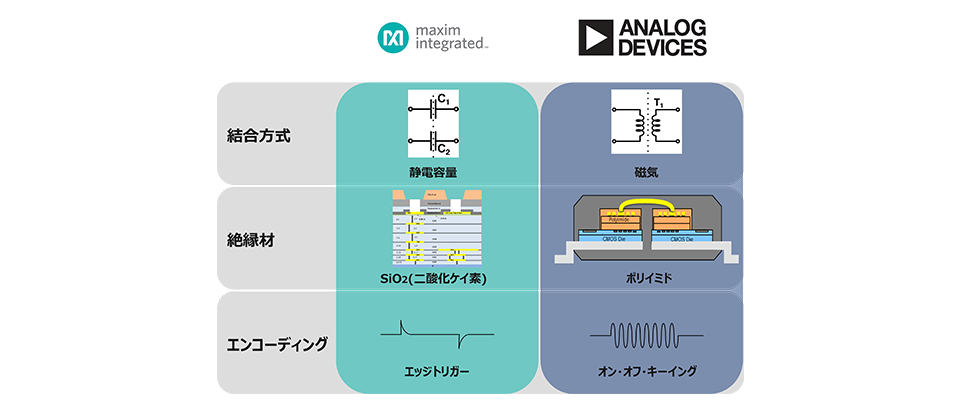
詳しく知りたい方は、前編を併せてお読みください。
→前編はこちら【デジタルアイソレーター対決(前編):磁気 vs 静電容量】
前編では、磁気絶縁方式のラインナップを紹介しました。旧来のアナログ・デバイセズ社の製品で、絶縁材にポリイミドを使用し、エンコーディングはオン・オフ・キーイングを用いています。
今回は、静電容量方式による旧Maximのラインナップを紹介します。
【ラインナップ紹介・後編】旧Maximの静電容量方式
旧Maximの静電容量方式のラインナップは、絶縁材にSiO2(二酸化ケイ素)を使用し、エンコーディングはエッジトリガーを採用しています。このラインナップには、どのような特長があるのでしょうか。
主要な特長として、高速データレート、低伝搬遅延、低ジッター、低消費電力が挙げられます。これらは、ポリイミドを使用した磁気結合方式には見られないメリットです。
下に、詳細な構成図を示します。
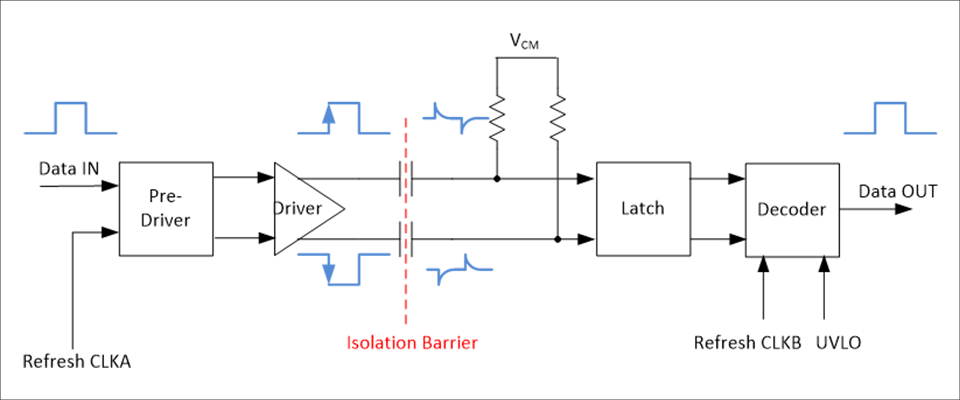
製品ラインナップの中から突出しているスペックを抜粋すると、「データレート最大200Mbps」、「伝搬遅延10ns以下」、「1チャンネルあたりの消費電力0.65mA以下(1Mbps通信時)」など、魅力的な数字が並びます。静電容量方式ならではの特長が充実したラインナップです。
|
データレート:最大200Mbps |
|
1Mbps通信時の1chあたり消費電力:0.65mA以下 |
|
伝搬遅延:10ns以下 |
|
ジッター:8ps |
|
チャンネル間スキュー:1ns |
静電容量方式アイソレーター(旧Maxim社ラインナップ)の突出したスペック
なぜ「低伝搬遅延」が重要なのか?
なぜ、デジタルアイソレーターにおいて低伝搬遅延が重要なのでしょうか。その理由を説明しましょう。
伝搬遅延 (propagation delay) とは、簡単に言うと、デジタルアイソレーター内部の入力から出力までの遅延のことです。
例えば、下図のようにマイクロコントローラーユニット (MCU) とA/Dコンバーター (ADC) でSPI通信をおこない、間にデジタルアイソレーターを置いて絶縁させる場合を考えてみましょう。
MCUからADCのサンプリング基準となるクロック (SCLK) を送信し、ADCはMCUにAD変換結果を応答します。
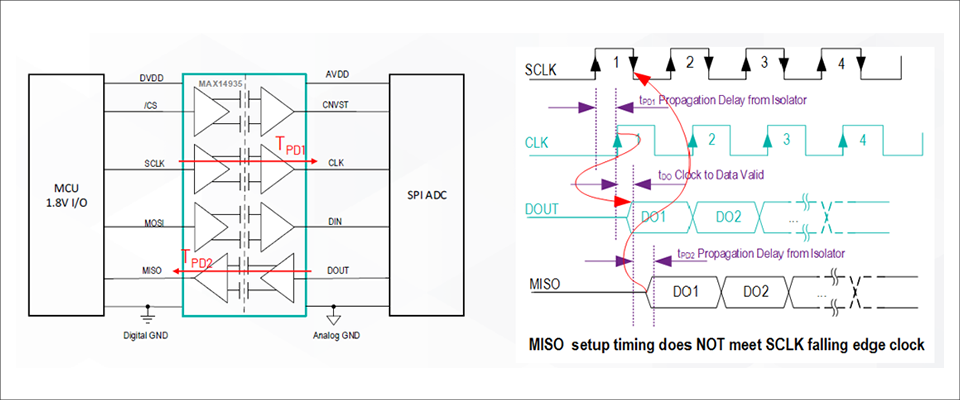
このとき、間にあるデジタルアイソレーターの伝搬遅延が加わることで、ADCのラッチが適切なタイミングで実行されなくなり、意図したデータと得られるデータにズレが生じる可能性があります。
伝搬遅延によるズレを防ぐために、ADCのサンプリング速度を落とすなどの調整が必要になり、理想のシステム設計からの妥協を強いられるかもしれません。
特に、光や音などの高速サンプリングが求められるアプリケーションでは、伝搬遅延の仕様が大きく影響します。そのため、伝搬遅延が限りなく低いことが望ましいのです。
なぜ「低ジッター」が重要なのか?
また、静電容量方式のラインナップは低ジッターであることも利点の1つです。ジッターはどのような性能に影響するのでしょうか。
ジッターとは、タイミングの揺らぎのことです。A/D変換の観点では、ジッターが大きいとACCのサンプリングポイントがずれてしまい、歪みやノイズと化し、信号対雑音比 (SNR) が劣化します。
特に、高精度な測定の場合、クロックジッターが重要な指標となることを頭に入れておきましょう。
【ラインナップ(1) MAX22445】業界トップレベルの高速4チャンネルアイソレーター
それでは、具体的なラインナップを紹介していきましょう。
静電容量方式の特色を十分に活用し、業界トップレベルの高速データレートと低い伝搬遅延を実現しているのが、4チャンネルアイソレーター「MAX22445」です。最大データレート200Mbps、ジッター8psRMSは、いずれも注目に値するスペックです。
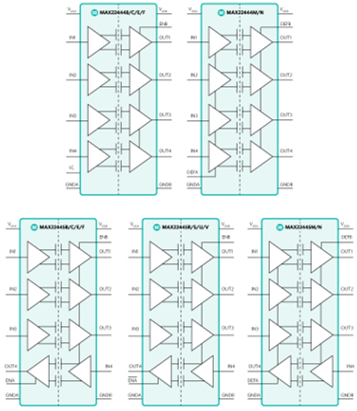
・高いタイミング性能
-最大データレート:200Mbps
-低ジッター:8psRMS
-低伝搬遅延:10ns
-低チャンネル間スキュー:2ns
・低消費電力
-各チャンネル 0.74mW(1Mbps通信時, VDD=1.8V)
・強化絶縁
-絶縁耐圧 (VISO):5kVRMS
-連続耐圧(VIOWM):1500VRMS
-CMTI:50kV/µs
・使いやすい
-電源電圧範囲:1.71V~5.5V
-動作温度範囲:-40℃~+125℃
■ アプリケーション例
・通信基地局
・光や音など高速かつ高精度な計測が求められるアプリケーション
磁気絶縁方式「ADuM341E」との比較
このMAX22445を、前編で紹介した磁気絶縁方式のおすすめデジタルアイソレーター「ADuM341E」と比較すると、どのような違いがあるのでしょうか。比較表をご覧ください。
堅牢性なら旧ADI、タイミング性能&消費電力なら旧Maximが有利
データレートを比較すると、ADuM341Eの150Mbpsに対して、MAX22445は200Mbpsで、より高速な通信が可能です。さらに、伝搬遅延もMAX22445がより低いため、高速通信にはMAX22445が優位性を持つことがわかります。MAX22445は消費電力も大幅に低く、ADuM341Eと比べて約4分の1に抑えられています。
一方、堅牢性の指標となる強化絶縁耐圧やCMTIでは、ADuM341Eが優れています。
比較表からもわかるように、デジタルアイソレーターの堅牢性を求めるアプリケーションには、磁気結合方式を中心とする旧アナログ・デバイセズのラインナップが適しています。これに対して、高速通信や低消費電力を求めるアプリケーションでは、静電容量方式の旧Maximのラインナップが活躍します。
【ラインナップ(2) MAX22820】超低消費電力、2チャンネル強化絶縁アイソレーター
次に紹介するのは、1Mbps通信時に54.7μAという、極めて小さい消費電力が魅力の「MAX22820」です。通信速度よりも消費電力を重視するアプリケーションに最適な仕様を実現しています。例えば、バッテリー駆動のIoT機器などにフル活用していただけます。
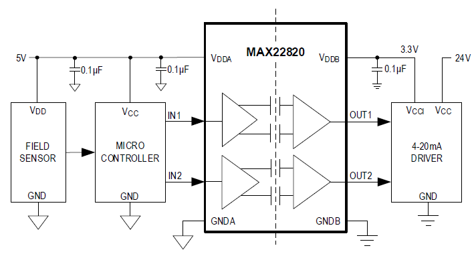
・最大データレート:10Mbps
・超低消費電力(1チャンネルあたり, VDD=3.3V)
-11.4µA (DC)
-15.4μA (100kbps)
-54.7μA (1Mbps)
・強化絶縁
-絶縁耐圧:5kVRMS WSOICパッケージ
-絶縁耐圧:3kVRMS NSOICパッケージ
-CMTI:200kV/µs
・使いやすい
-電源電圧範囲:1.71V~5.5V
-動作温度範囲:-40℃~+125℃
■ アプリケーション例
・IoT機器
・ポータブル計測器
・ハンディーターミナル
このように、旧Maximの静電容量方式ラインナップには、高速通信を強みとする製品もあれば、低消費電力を強みとする製品もあります。ニーズに合わせてさまざまな製品から選定していただくことが可能です。
前編・後編にわたり、アナログ・デバイセズのデジタルアイソレーターを紹介しました。デジタルアイソレーターは、絶縁材や結合方式によって特長が異なり、用途に合わせた選択が必要です。堅牢性に優れた旧アナログ・デバイセズ製品、消費電力やスピードに秀でた旧Maxim製品と、豊富なラインナップがそろっています。
今回の記事を参考にしながら、ご自身のアプリケーションに最適なデジタルアイソレーターを選択していただけたら幸いです。
いずれも評価ボードが提供されており、すぐにお試しいただけます。
ご質問がありましたら、お気軽にお問い合わせください。
アプリケーション例
- 通信基地局などの高速かつ高精度な計測が求められるアプリケーション
- ポータブル計測器などの低消費電力が求められるアプリケーション

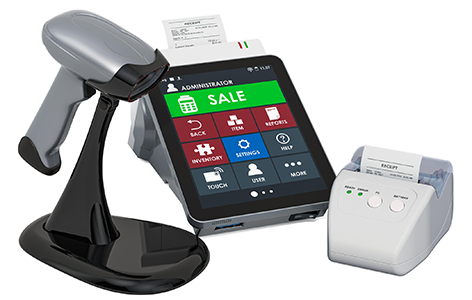
商品の購入はこちら
メーカーサイト/その他関連リンクはこちら
お問い合わせ
本記事に関してご質問がありましたら、以下よりお問い合わせください。
アナログ・デバイセズ メーカー情報Topへ
アナログ・デバイセズ メーカー情報Topに戻りたい方は以下をクリックしてください。
